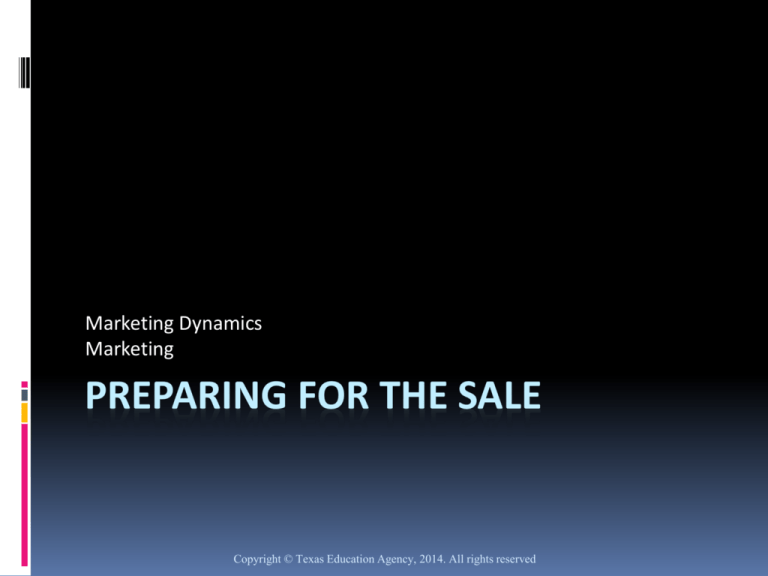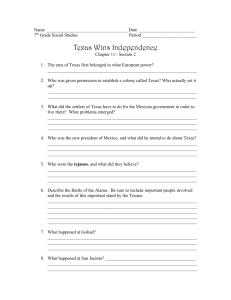
Marketing Dynamics
Marketing
PREPARING FOR THE SALE
Copyright © Texas Education Agency, 2014. All rights reserved
Copyright
Agency and will be required to enter into a license agreement that may involve the payment Copyright ©
Texas Education Agency. The materials found on this website are copyrighted © and trademarked ™ as
the property of the Texas Education Agency and may not be reproduced without the express written
permission of the Texas Education Agency, except under the following conditions:
1) Texas public school districts, charter schools, and Education Service Centers may reproduce and use
copies of the Materials and Related Materials for the districts’ and schools’ educational use without
obtaining permission from the Texas Education Agency;
2)
Residents of the state of Texas may reproduce and use copies of the Materials and Related
Materials for individual personal use only without obtaining written permission of the Texas
Education Agency;
3)
Any portion reproduced must be reproduced in its entirety and remain unedited, unaltered and
unchanged in any way;
4)
No monetary charge can be made for the reproduced materials or any document containing them;
however, a reasonable charge to cover only the cost of reproduction and distribution may be
charged.
Private entities or persons located in Texas that are not Texas public school districts or Texas charter
schools or any entity, whether public or private, educational or non-educational, located outside the state
of Texas MUST obtain written approval from the Texas Education t of a licensing fee or a royalty fee.
Copyright © Texas Education Agency, 2014. All rights reserved
Goals
The student can differentiate among a feature, an
advantage, and a benefit.
The student can compare and contrast between consumer,
organizational buying behavior
The student can determine customer needs and wants
The student can classifying buying motives
The student can analyze how customers and organizations
apply the decision-making process.
The student can identify major influences on buying
behavior
The student can acquire information about customer needs
Copyright © Texas Education Agency, 2014. All rights reserved
Terms
Personal Selling
Business-to-Business
Product feature
Customer benefit
Feature-benefit selling
Rational motive
Emotional motive
Extensive decision making
Limited decision making
Routine decision making
Copyright © Texas Education Agency, 2014. All rights reserved
Types of Sales
Personal Selling involves any form of direct
contact between a salesperson and a
customer.
Personal Selling can be involved in different type of
sales situations.
Business-to-business selling
Also called B2B
Manufacturer or wholesaler selling to another
business.
Copyright © Texas Education Agency, 2014. All rights reserved
Feature Benefit Selling
Feature Benefit Selling – a good salesperson can
translate the products features into how they
will benefit the customer.
Product Features
Basic, physical or extended attributes of the product.
Example: Digital Image Stabilization (D.I.S.)
Customer Benefits
How that feature helps the product
How does the feature give a customer a reason to buy.
Example: D.I.S. helps to reduce the camera shaking so
you can take a better picture from further away.
Copyright © Texas Education Agency, 2014. All rights reserved
Customer Buying Motives
Rational motive – a conscious, logical reason
to make a purchase.
Dependable product
Cost savings
Better health
Safety considerations
Quality of product
Copyright © Texas Education Agency, 2014. All rights reserved
Customer Buying Motives
Emotional motives that involve feelings that a
customer has that are associated with the
product.
Social approval
Recognition
Power
Love
prestige
Copyright © Texas Education Agency, 2014. All rights reserved
Customer Decision Making
Factors that affect decision making
Previous experience with a product or company
How often the product is purchased
The amount of information necessary to make a
decision.
The importance of the decision to the consumer.
The perceived risk involved in the purchase
The time allotted to make the decision.
Copyright © Texas Education Agency, 2014. All rights reserved
Customer Decision Making
Extensive Decision Making
Little or no prior experience with the product.
High degree of perceived risk or
Very expensive product
Examples are
(B2B) Expensive machinery
(B2B) Land or buildings
First cars
First homes
Copyright © Texas Education Agency, 2014. All rights reserved
Customer Decision Making
Limited Decision Making
Person has already purchased product before but not
regularly
Moderate degree of perceived risk
Customer requires information before making
purchase.
Examples
(B2B) Accounting services
(B2B) Advertising agency services
Second car
Appliances
Vacations
Copyright © Texas Education Agency, 2014. All rights reserved
Customer Decision Making
Routine Decision Making
Customer needs little information about product
High degree of prior experience with product
Low risk
Examples:
(B2B) reorder goods
(B2B) office supplies
Groceries
Dry-cleaning
Hairdressing services
Copyright © Texas Education Agency, 2014. All rights reserved
What makes a good salesperson?
Good communication skills
Good interpersonal skills
Solid technical skills
Positive attitude and self-confidence
Goal oriented
Empathy
Honesty
Enthusiasm
Copyright © Texas Education Agency, 2014. All rights reserved
Determining Needs
Determine needs as soon as possible.
Ask questions
Don’t assume
Copyright © Texas Education Agency, 2014. All rights reserved
Determining Needs
Observing – observe customer to look for buying motives
Look for nonverbal clues. Study facial expressions, hand
motions, eye movement etc. to determine customers interest or
mood.
How long they hold the product.
In B2B sales look for clues in office for personal interests.
In retail sales walk through store and observe customers, items
carried and prices.
Copyright © Texas Education Agency, 2014. All rights reserved
Determining Needs
Listening – helps you pick up clues to customers
needs and for use in product presentation.
listening skills
Maintain good eye contact
Provide verbal and nonverbal feedback
Give customers your undivided attention
Do not interrupt
Copyright © Texas Education Agency, 2014. All rights reserved
Determining Needs
Questioning – in order to listen you must get
them talking.
Begin with general questions about intended use or
product and pervious experience with product.
Build your questions around words like who, what,
when, where, how and why.
Then begin asking more detailed questions, like
size, color or features.
Copyright © Texas Education Agency, 2014. All rights reserved
Determining Needs
Do’s and Don'ts for asking questions:
Do ask open-ended questions to encourage
talking.
Do ask qualifying questions to make sure you
understand customer needs.
Don’t ask too many questions in a row.
Don’t ask questions that might embarrass
customer or put them on defensive.
Copyright © Texas Education Agency, 2014. All rights reserved








